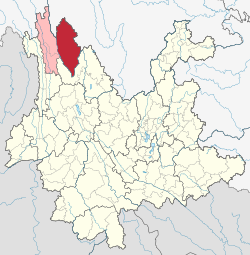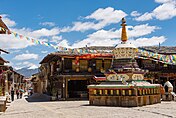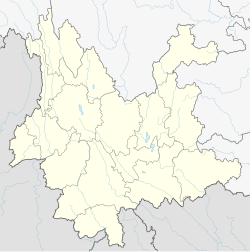This article includes a list of general references, but it lacks sufficient corresponding inline citations. (July 2012) |
Shangri-La (Chinese: 香格里拉; pinyin: Xiānggélǐlā; Tibetan: སེམས་ཀྱི་ཉི་ཟླ།) is a county-level city in northwestern Yunnan province, China, named after the mythical land depicted in the 1933 novel Lost Horizon. It is the capital and largest city of Diqing Tibetan Autonomous Prefecture. It is bordered by the city of Lijiang to the south and Sichuan province to the northwest, north, and east.
Shangri-La
香格里拉市 · སེམས་ཀྱི་ཉི་ཟླ་གྲོང་ཁྱེར། | |
|---|---|
 Location of Shangri-La (red) in Diqing Tibetan Autonomous Prefecture (pink) within Yunnan | |
| Coordinates (Diqing Prefecture government): 27°50′45″N 99°44′32″E / 27.84583°N 99.74222°E | |
| Country | China |
| Province | Yunnan |
| Autonomous prefecture | Diqing |
| Municipal seat | Gyalthang Town |
| Area | |
• Total | 11,613 km2 (4,484 sq mi) |
| Elevation | 3,160 m (10,370 ft) |
| Population (2020 census)[2] | |
• Total | 186,412 |
| • Density | 16/km2 (42/sq mi) |
| Time zone | UTC+8 (China Standard) |
| Postal code | 674400 |
| Area code | 0887 |
| Website | xianggelila |
| Shangri-La, Yunnan | |||||||||||
|---|---|---|---|---|---|---|---|---|---|---|---|
| Chinese name | |||||||||||
| Chinese | 香格里拉 | ||||||||||
| |||||||||||
| Alternative Chinese name | |||||||||||
| Chinese | 中甸 | ||||||||||
| |||||||||||
| Tibetan name | |||||||||||
| Tibetan | སེམས་ཀྱི་ཉི་ཟླ། | ||||||||||
| |||||||||||
Name
editThe city was originally a county named Zhongdian (中甸县; Zhōngdiàn Xiàn); the Tibetan population referred to the area by its traditional name Gyalthang (Tibetan: རྒྱལ་ཐང་, Wylie: rgyal thang, ZYPY: Gyaitang), meaning "royal plains". On 17 December 2001, the Chinese government renamed the county "Shangri-La", after the fictional land of Shangri-La in the 1933 James Hilton novel Lost Horizon. This renaming, along with the county's upgrade to a county-level city on 16 December 2014, was part of an effort by the Chinese government to promote tourism in the area. The Chinese name of the county seat, Jiantang (建塘; Jiàntáng), reflects a Mandarin transliteration of Gyalthang.
History
editIn the early morning of 11 January 2014, a fire broke out in the 1,000-year-old Dukezong Tibetan neighborhood. About 242 homes and shops were destroyed and 2,600 residents were displaced.[3] About half of the old town was destroyed by the fire. Afterwards, residents were allowed back to their homes and shops. By the end of 2014 rebuilding had started and tourism started to return. Tourism was generally not affected by the fire, since the main sights in the old town, such as the prayer wheel and temples, were not damaged. Many of the other main sights are located outside of the old town.
Demographics and languages
editThe southern half of the city is inhabited by the Naxi people, who speak the Naxi language, a Lolo-Burmese language separate from the Tibetic languages. The northern half is inhabited by the Khampas, who speak the southern variety of Khams Tibetan. Southwestern Mandarin is spoken by the Han Chinese throughout the city.
The ambiance of the town is distinctly Tibetan with prayer flags fluttering, mountains known by holy names, lamaseries and rocks inscribed in Tibetan language with Buddhist sutras.[4][5][6]
Administrative divisions
editShangri-La city has 4 towns, 6 townships and 1 ethnic township.[7]
| Name | Simplified Chinese | Hanyu Pinyin | Tibetan | Wylie | Administrative division code | |
|---|---|---|---|---|---|---|
| Towns | ||||||
| Gyalthang Town (Jiantang) |
建塘镇 | Jiàntáng zhèn | རྒྱལ་ཐང་གྲོང་རྡལ། | rgyal thang grong rdal | 533401101 | |
| Yangthang Town (Xiaozhongdian) |
小中甸镇 (洋塘镇) |
Xiǎozhōngdiàn zhèn | ཡང་ཐང་གྲོང་རྡལ། | yang thang grong rdal | 533401102 | |
| Hutiaoxia Town | 虎跳峡镇 | Hǔtiàoxiá zhèn | 533401103 | |||
| Jinjiang Town | 金江镇 | Jīnjiāng zhèn | 533401104 | |||
| Townships | ||||||
| Shangjiang Township | 上江乡 | Shàngjiāng xiāng | 533401201 | |||
| Luoji Township | 洛吉乡 | Luòjí xiāng | 533401203 | |||
| Nyishar Township (Nixi) |
尼西乡 | Níxī xiāng | ནོར་སྐྱིད་ཞང་། | nyi shar zhang | 533401204 | |
| Ketsak Township (Gezan) |
格咱乡 | Gézán xiāng | སྐད་ཚག་ཤང་། | skad tshag shang | 533401205 | |
| Dorwarong Township (Torwarong, Dongwang) |
东旺乡 | Dōngwàng xiāng | གཏོར་བ་རོང་ཤང་། | gtor ba rong shang | 533401206 | |
| Rongpagyurnga Township (Wujing) |
五境乡 | Wǔjìng xiāng | རོང་པ་སྒྱུར་ལྔ་ཤང་། | rong pa sgyur lnga shang | 533401207 | |
| Ethnic township | ||||||
| Sanba Naxi Ethnic Township | 三坝纳西族乡 | Sānbà Nàxīzú xiāng | 533401202 | |||
Climate
editShangri-La has either a dry-winter, warm-summer humid continental climate (Köppen climate classification: Dwb) using the 0 °C (32 °F) isotherm, or a dry-winter subtropical highland climate (Köppen climate classification: Cwb) using the −3 °C (26.6 °F) isotherm, both of which are unusually cool by Yunnan standards due to the high elevation, which ranges between 2,700 and 3,500 metres (8,900 and 11,500 ft). Winters are chilly but sunny, with a 24 hour January average temperature of -2.0 °C (28.4 °F), while summers are cool, with a 24 July-hour average temperature of 13.9 °C (57.0 °F), and feature frequent rain; more than 70% of the annual precipitation is delivered from June to September. The annual mean is 6.32 °C (43.4 °F). Except during the summer, nights are usually sharply cooler than the days. Despite the dryness of the winter, the small amount of precipitation is generally sufficient to cause major transportation dislocations and isolate the area between November and March.
| Climate data for Shangri-La, elevation 3,342 m (10,965 ft), (1991–2020 normals, extremes 1971–2010) | |||||||||||||
|---|---|---|---|---|---|---|---|---|---|---|---|---|---|
| Month | Jan | Feb | Mar | Apr | May | Jun | Jul | Aug | Sep | Oct | Nov | Dec | Year |
| Record high °C (°F) | 20.4 (68.7) |
18.2 (64.8) |
21.5 (70.7) |
22.7 (72.9) |
24.2 (75.6) |
26.0 (78.8) |
26.0 (78.8) |
25.5 (77.9) |
23.8 (74.8) |
20.9 (69.6) |
18.8 (65.8) |
17.9 (64.2) |
26.0 (78.8) |
| Mean daily maximum °C (°F) | 6.9 (44.4) |
7.8 (46.0) |
9.9 (49.8) |
13.0 (55.4) |
16.8 (62.2) |
19.7 (67.5) |
19.4 (66.9) |
19.2 (66.6) |
17.9 (64.2) |
14.9 (58.8) |
11.6 (52.9) |
8.9 (48.0) |
13.8 (56.9) |
| Daily mean °C (°F) | −2.0 (28.4) |
0.1 (32.2) |
3.0 (37.4) |
6.1 (43.0) |
10.1 (50.2) |
13.8 (56.8) |
14.0 (57.2) |
13.5 (56.3) |
12.1 (53.8) |
7.6 (45.7) |
2.4 (36.3) |
−1.1 (30.0) |
6.6 (43.9) |
| Mean daily minimum °C (°F) | −9.2 (15.4) |
−6.1 (21.0) |
−2.4 (27.7) |
0.6 (33.1) |
4.6 (40.3) |
9.4 (48.9) |
10.6 (51.1) |
10.1 (50.2) |
8.5 (47.3) |
2.3 (36.1) |
−4.6 (23.7) |
−8.9 (16.0) |
1.2 (34.2) |
| Record low °C (°F) | −23.9 (−11.0) |
−20.5 (−4.9) |
−17.5 (0.5) |
−10 (14) |
−7.4 (18.7) |
−2.1 (28.2) |
1.1 (34.0) |
1.0 (33.8) |
−3.0 (26.6) |
−11.1 (12.0) |
−16.5 (2.3) |
−27.4 (−17.3) |
−27.4 (−17.3) |
| Average precipitation mm (inches) | 12.2 (0.48) |
14.6 (0.57) |
30.6 (1.20) |
26.9 (1.06) |
44.5 (1.75) |
72.0 (2.83) |
159.9 (6.30) |
155.5 (6.12) |
80.1 (3.15) |
32.8 (1.29) |
8.7 (0.34) |
3.5 (0.14) |
641.3 (25.23) |
| Average precipitation days (≥ 0.1 mm) | 5.4 | 5.9 | 9.8 | 10.0 | 11.9 | 15.5 | 22.3 | 23.0 | 17.8 | 9.7 | 2.7 | 1.7 | 135.7 |
| Average snowy days | 9.4 | 11.4 | 13.2 | 4.1 | 0.3 | 0 | 0 | 0 | 0.2 | 0.6 | 4.0 | 4.8 | 48 |
| Average relative humidity (%) | 57 | 59 | 62 | 64 | 66 | 70 | 78 | 79 | 77 | 70 | 61 | 55 | 67 |
| Mean monthly sunshine hours | 239.3 | 208.6 | 202.1 | 184.7 | 189.9 | 150.3 | 108.1 | 120.3 | 127.7 | 189.7 | 228.3 | 253.7 | 2,202.7 |
| Percent possible sunshine | 73 | 65 | 54 | 48 | 45 | 36 | 26 | 30 | 35 | 54 | 71 | 79 | 51 |
| Source 1: China Meteorological Administration[8][9] | |||||||||||||
| Source 2: Weather China[10] | |||||||||||||
National park
edit- Pudacuo National Park, the first national park in China to meet IUCN standards, is part of the Three Parallel Rivers of Yunnan Protected Areas World Heritage Site.
Transport
edit- Shangri-La railway station on Lijiang–Shangri-La railway opened on 26 November 2023.[11] It takes 1h 20min to reach Lijiang by train, and about 5h to the provincial capital Kunming.[12]
- The city's airport is Diqing Shangri-La Airport. Covering an area of 225 hectares, it is one of the biggest airports in the northwest of Yunnan. There are flights to Kunming, Chengdu, Lhasa, Guangzhou and Shenzhen.
- Taking a long-distance bus is also a major means to get to Shangri-La. It takes about four hours to get to Shangri-La from Lijiang by bus. Tourists who rent a car for the trip can also visit the Tiger Leaping Gorge (Hutiaoxia, 虎跳峡) and the First Bend of Yangtze River on the way.[13]
- Many travelers use the county town as a gateway into Tibet, either travelling many days overland by jeep to Lhasa, or by flying from the city's airport. However, the town itself is a tourist destination, primarily due to the nearby Gandan Sumtseling Monastery, Ganden Sumtsen Ling, 松赞林寺 Sōngzànlín Sì), Pudacuo National Park, and Tiger Leaping Gorge.
- China National Highway 214
See also
edit- Shangri-La Beer
- Three Parallel Rivers of Yunnan Protected Areas – UNESCO World Heritage Site
References
edit- ^ "Shangri-La (Xiānggélǐlā 香格里拉), chef-lieu de la préfecture autonome tibétaine de Diqing, Yunnan (Yúnnán 云南)". channaryetfrancoisashanghai.net (in French). Retrieved 10 August 2015.
- ^ "迪庆州第七次全国人口普查主要数据公报" (in Chinese). Government of Diqing Prefecture. 27 May 2021.
- ^ "Night fire burns for hours, destroys ancient Tibetan town in southwest China's Shangri-La county". Toledo Blade. 11 January 2014.
- ^ Reilly, James O'; Sean O'Reilly; Larry Habegger James (2004). Travelers' Tales China: True Stories. Travelers' Tales. p. 162. ISBN 1-932361-07-3. Retrieved 18 March 2010.
- ^ Mansfield, Stephen; Martin Walters (2007). China: Yunnan Province. Bradt Travel Guides. pp. 165–166. ISBN 978-1-84162-169-2. Retrieved 17 March 2010.
- ^ "Shangri-La, Ganden Sumtseling Monastery". Virtual Tourist. Retrieved 17 March 2010.
- ^ "国家统计局" (in Chinese). National Bureau of Statistics of the People's Republic of China. Retrieved 7 December 2021.
- ^ 1981–2010 extremes 中国气象数据网 – WeatherBk Data (in Simplified Chinese). China Meteorological Administration. Retrieved 9 April 2023.
- ^ 1991–2020 normals "Climate averages from 1991 to 2020". China Meteorological Administration. 24 April 2023. Archived from the original on 17 April 2023.
- ^ 1971–2000 extremes 香格里拉 – 气象数据 -中国天气网 (in Chinese). Weather China. Archived from the original on 5 April 2023. Retrieved 21 November 2022.
- ^ "丽香铁路 11月26日开通运营".
丽江至香格里拉铁路(以下简称丽香铁路)将于11月26日建成通车
- ^ "丽香铁路通车 动车直达"吉祥如意的地方". Xinhua. 26 November 2023.
- ^ "Shangri-la Transportation" ChinaTour.net Accessed 9 May 2014
Further reading
edit- Forbes, Andrew ; Henley, David (2011). China's Ancient Tea Horse Road. Chiang Mai: Cognoscenti Books. ASIN: B005DQV7Q2
- Holas, Ashild. "Tourism and Tibetan Culture in Transition: A Place Called Shangrila" (Routledge Contemporary China Series). Routledge, 12 September 2007. ISBN 8173871094, 9788173871092.



